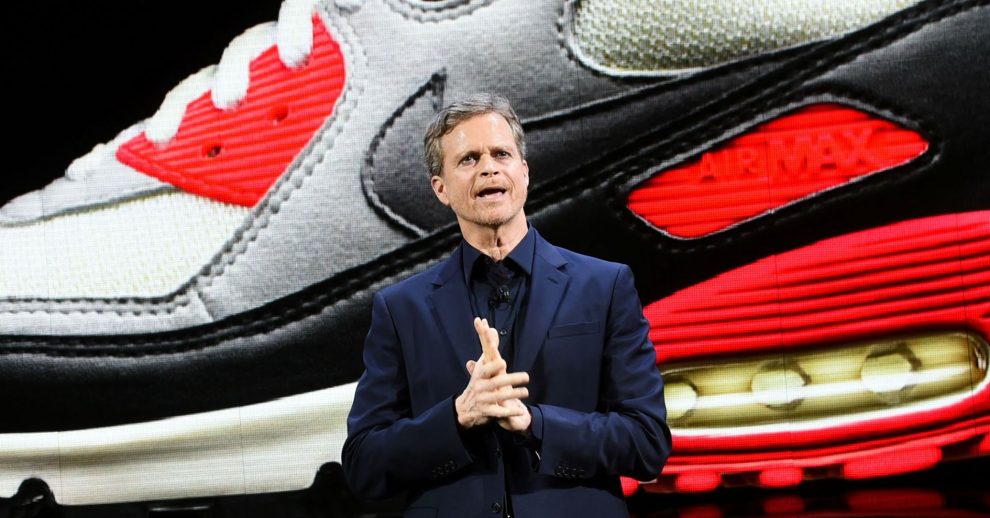
Nike shares tumbled Thursday following the sneaker maker reporting weaker-than-expected sales in North America during its fiscal third quarter, hurt, in part, by fewer people buying Converse-branded merchandise.
Although its earnings topped analysts’ expectations, and total revenue was in-line with estimates, Nike shares sunk more than 4 percent after the bell on the news. The stock had closed the day at a record high of $88.01.
Here’s what Nike reported for its fiscal third quarter compared with what analysts were expecting, based on a poll by Refinitiv:
* Earnings per share, adjusted: 68 cents vs. 65 cents expected
* Revenue: $9.611 billion vs. $9.612 billion expected
“Our business momentum is being accelerated by our ability to scale innovation at a faster pace and expand new digital consumer experiences around the world,” CEO Mark Parker said. The company also called out “continued momentum in China,” a geography it’s said it’s still “bullish” about despite uncertainty about tariffs.
“We have great momentum in China, but we are still far from realizing the long-term opportunity in this market,” CFO Andy Campion told analysts.
Nike reported net income of $1.1 billion, or 68 cents a share, compared with a net loss of $921 million, or a loss of 57 cents per share, a year ago. Earnings per share came in 3 cents ahead of analysts’ expectations, based on a survey by Refinitiv.
Revenue was up 7 percent during the quarter to $9.611 billion from $8.984 billion a year ago. That was about in-line with what analysts had expected. It marked the first time in six quarters, though, that Nike didn’t top expectations.
Within that, sales at the Converse shoe brand were down 2 percent to $463 million, primarily driven by declines in the U.S. and Europe, the company said.
In North America, sales were up 7 percent to $3.81 billion, excluding currency changes. That was softer growth than what some people had expected. Telsey Advisory Group analyst Cristina Fernandez was calling for North American sales to be up 10 percent during the third quarter.
In Europe, the Middle East and Africa, sales were up 12 percent, excluding currency changes, Nike said. In China, revenue climbed 24 percent. And in Asia Pacific and Latin America, sales grew 14 percent, as Nike’s business continues to grow more overseas than in the U.S., which remains saturated with competition from the likes of Adidas, Under Armour and Vans.
Nike said its digital business surged 36 percent, as it continues to invest in online initiatives like its mobile app and customization options for customers. The company said shoppers using its Nike retail app to shop average 40 percent higher sales than those people who don’t.
It added traffic and sales through its “Snkrs” app — which sells limited-edition shoes using collaborations with athletes, celebrities and universities — climbed triple digits during the quarter.
Hoping to keep building momentum for its brand, Nike’s focus has shifted from its wholesale partners to now selling as much as it can directly to consumers, through its own stores and website. That’s evidenced by Nike’s recent store openings, which include a high-tech flagship location in New York on Fifth Avenue, and a new smaller-format store it’s testing in Los Angeles. Nike’s online business, meanwhile, has been strong as long as the company has innovated with new products — like the Air Max 720 and the Epic React Flyknit 2 — and exclusive launches that drive traffic to the website.
“The innovation pipeline is full at Nike and it gives us great confidence that we’ll continue to win with the consumers for years to come,” Parker said.
Looking for pockets of growth, Nike has said it plans to invest more in apparel — for both men and women — and women’s products in the future. For female customers, it’s launching more items like yoga pants and sports bras in expanded sizes. The company said, as of the third quarter, its Jordan business for women is growing at a double-digit rate, and women are “embracing the sneaker culture more and more every day.”
“The women’s business is over-indexing our men’s growth,” Parker said. “And we see … tremendous opportunity moving forward. … We’ve had [a] real strong response to the Nike yoga collection.”
Nike is, meanwhile, expected to have benefited as rival sneaker maker Adidas’ North American sales growth has decelerated. Adidas has said it will face “supply chain shortages” in 2019, as it’s struggling to come up with new styles that pique customers’ interests.
“We foresee continued share erosion [at Adidas] due to Nike’s superior product platform,” Jefferies analyst Randal Konik said ahead of Thursday’s report.
One cloud hanging over Nike ahead of Thursday’s results: The company was caught up in controversy recently when Duke University star basketball player Zion Williamson blew through his Nike sneakers during a basketball game and sprained his knee. Nike shares fell following the debacle. The company responded by sending a team of sneaker designers to Duke in North Carolina, and then to China, to make a new shoe for Williamson, who has since returned to playing basketball after having to sit out some games with his injury.
But there was no mention of Williamson during Thursday’s earnings conference call.
Nike did say it repurchased 9.8 million shares, worth $754 million, during the quarter.
As of Thursday’s market close, Nike shares are up more than 30 percent over the past 12 months. The stock has climbed nearly 18 percent just this year.






